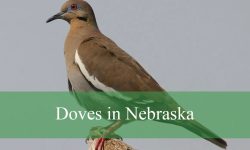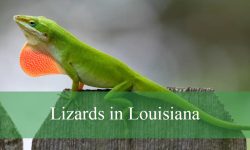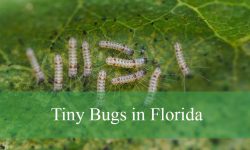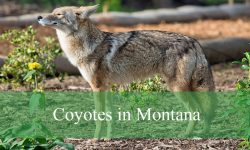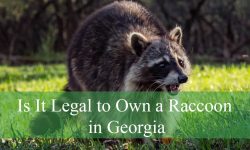California’s mild winters create a haven for birds escaping the harsher climates of the north. From the snow-tipped Sierra Nevada to the foggy coastal marshes, countless species settle across the state to rest, feed, and thrive. The season brings together both migratory visitors and resident birds, offering some of the most rewarding months for birdwatching.
As fall fades, sparrows, warblers, finches, and hawks begin to appear in every corner of the state. Backyard gardens, open grasslands, and lakes all become active with feeding flocks and bright flashes of color. Some species stay all year, while others pass through for only a few months before heading north again when spring returns.
This guide introduces twenty-five species of winter birds found throughout California. Each description includes their appearance, behavior, and preferred habitats to help you recognize them more easily during your next outdoor walk or birdwatching trip.
Common Birds You Can See in California During Winter
Dark-eyed Junco (Junco hyemalis)
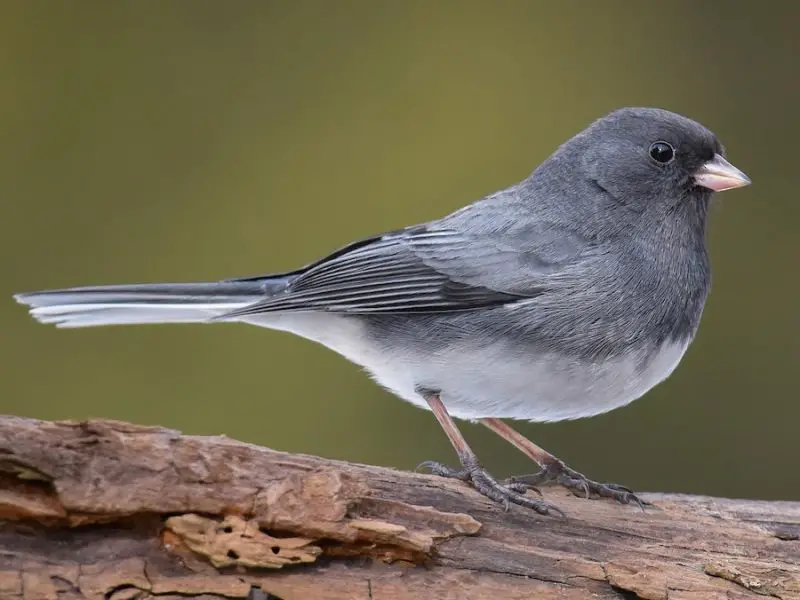
The Dark-eyed Junco is one of the most recognizable winter birds in California, easily spotted thanks to its dark hood, white belly, and pinkish bill. These small sparrows measure about 5 to 6 inches in length, with a short neck and a slightly rounded head. Their plumage varies slightly depending on the region, but the contrast between their dark head and light underparts remains consistent.
During the winter months, juncos gather in large flocks, often foraging on the ground for seeds scattered beneath trees or bird feeders. They hop quickly rather than walk and frequently flick their tails, revealing white outer feathers. Males and females are similar, though males tend to show darker coloration.
Dark-eyed Juncos prefer open woodlands, suburban yards, and coniferous forests, where they can find both shelter and food. In California, they are especially common in the Sierra Nevada foothills, urban parks, and gardens from late October through early March.
Their arrival each autumn signals the beginning of the colder season. Once spring returns, many individuals migrate northward or to higher elevations for breeding, leaving only a small resident population behind in cooler mountain regions.
White-crowned Sparrow (Zonotrichia leucophrys)
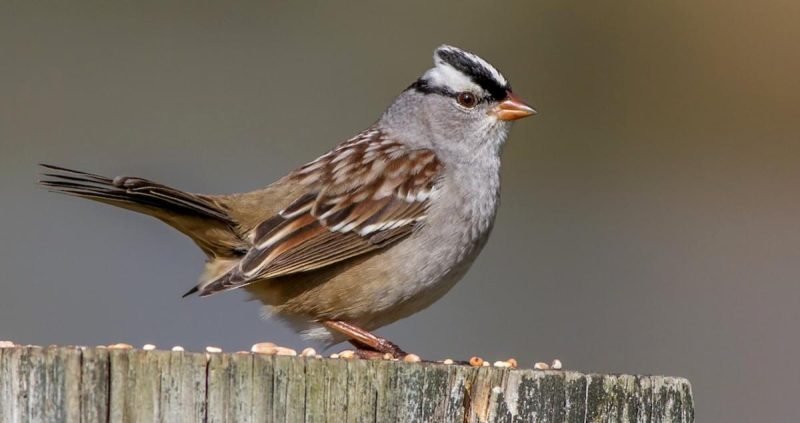
The White-crowned Sparrow is easily recognized by its bold black-and-white striped crown and gray face. Adults measure about 6 to 7 inches long with a slim build and long tail. Their bill ranges from pinkish to yellow, depending on the subspecies, and their overall appearance is sleek and clean-cut.
These sparrows are ground foragers, often seen hopping beneath shrubs or scratching through leaf litter in search of seeds and small insects. They are sociable birds, sometimes forming loose flocks with other sparrow species during the winter months.
In California, White-crowned Sparrows are abundant from late September through early April, particularly along the coast, in farmlands, and suburban gardens. Their cheerful whistled song can often be heard even on cool winter mornings, brightening otherwise quiet landscapes.
Many of these sparrows migrate northward to Alaska and Canada to breed in summer, but a few remain in the higher elevations of California’s mountains year-round, adapting well to local habitats.
Golden-crowned Sparrow (Zonotrichia atricapilla)
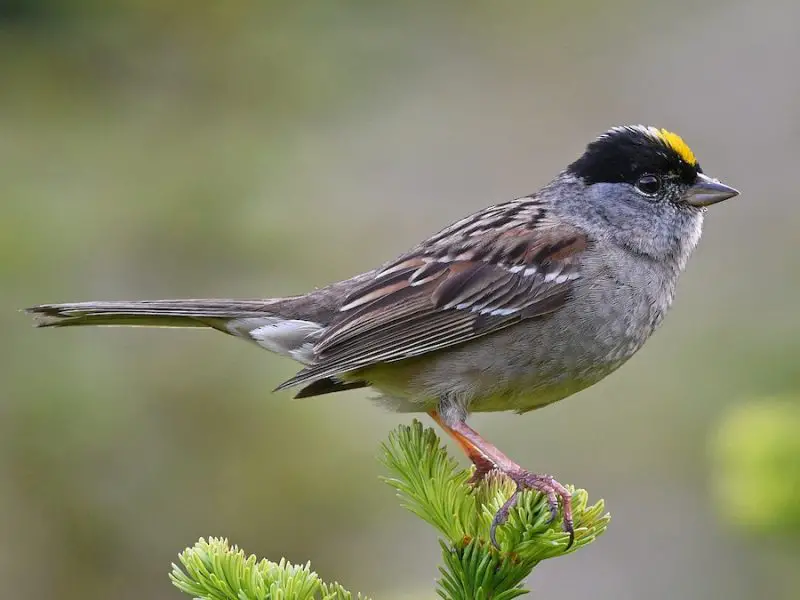
The Golden-crowned Sparrow is slightly larger than its white-crowned relative, with a distinctive golden-yellow patch on its forehead bordered by black. Adults are about 7 inches long, featuring grayish-brown plumage with streaked backs that blend beautifully with brushy environments.
These sparrows are shy and prefer dense cover, making them less conspicuous than White-crowned Sparrows. They typically forage quietly on the ground, feeding on seeds, weeds, and the occasional insect. During winter, they are often seen in small groups, frequently accompanying mixed flocks of other sparrows.
In California, Golden-crowned Sparrows arrive in September from their northern breeding grounds in Alaska and western Canada. They spend the entire winter along the coast and in the Central Valley, thriving in weedy fields, thickets, and gardens with low shrubbery.
Their soft, mournful whistling song is often described as “Oh dear me,” echoing across foggy winter mornings. By April, most depart northward again, leaving behind the first signs of spring migration.
Yellow-rumped Warbler (Setophaga coronata)
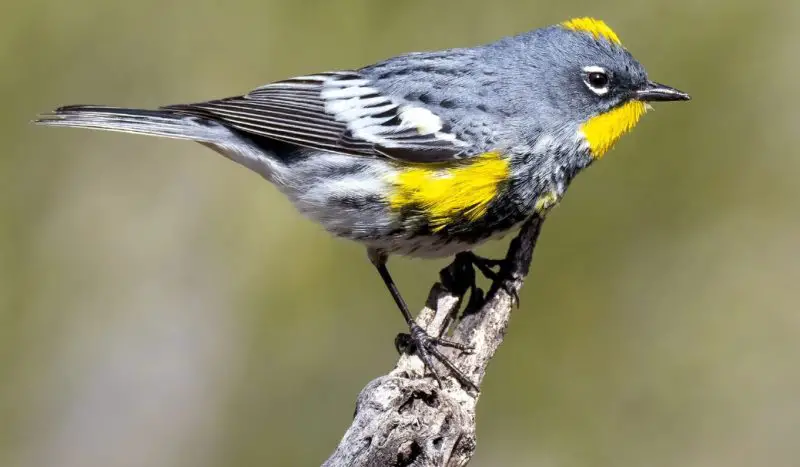
The Yellow-rumped Warbler stands out with its bright yellow patches on the rump, sides, and crown, which contrast with its gray back and white throat. These medium-sized warblers measure around 5.5 inches long and display slight plumage differences between the “Audubon’s” and “Myrtle” subspecies found across North America.
In winter, they are among the few warbler species that remain abundant in California, thanks to their unique ability to digest wax from bayberries and other fruits. This diet allows them to survive when insects become scarce, unlike most other warblers that migrate farther south.
Yellow-rumped Warblers can be seen flitting through trees, hedges, and open woodlands, often making short, darting flights to catch insects midair. They are active, sociable, and frequently visit birdbaths or suet feeders during cold spells.
From late October to early March, these birds are widespread throughout California — from the coast to the foothills and even in urban parks. As temperatures warm, they begin migrating northward or upward into forested mountain regions to breed.
Ruby-crowned Kinglet (Regulus calendula)
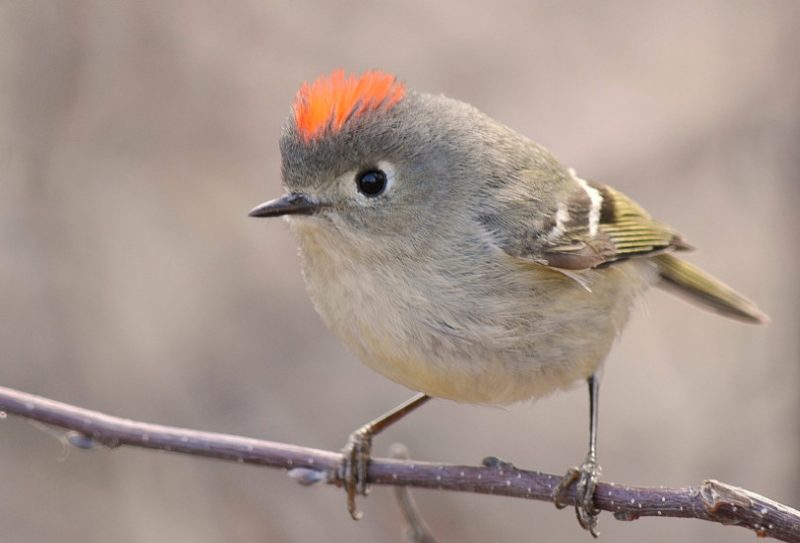
The Ruby-crowned Kinglet is one of California’s tiniest winter visitors, measuring just about 4 inches in length and weighing less than a quarter of an ounce. Males have a hidden ruby-red crown that they flash when agitated or during courtship, while females lack this feature. Their small, round bodies and constant movement make them easy to recognize once you’ve spotted one.
These birds are energetic and rarely stay still. They flit through branches, flicking their wings rapidly as they search for insects, spiders, and eggs hidden in bark crevices. Their high-pitched calls are often heard before they are seen, especially in wooded parks and backyard gardens.
During winter, Ruby-crowned Kinglets spread across much of California, from lowland suburbs to forested foothills. They adapt well to cooler weather, relying on dense foliage for warmth and protection. Despite their small size, they are remarkably hardy and active even on chilly mornings.
By March or April, many begin migrating northward to breed in the coniferous forests of the Pacific Northwest and Canada, leaving behind a few residents in the state’s higher mountain ranges.
Anna’s Hummingbird (Calypte anna)
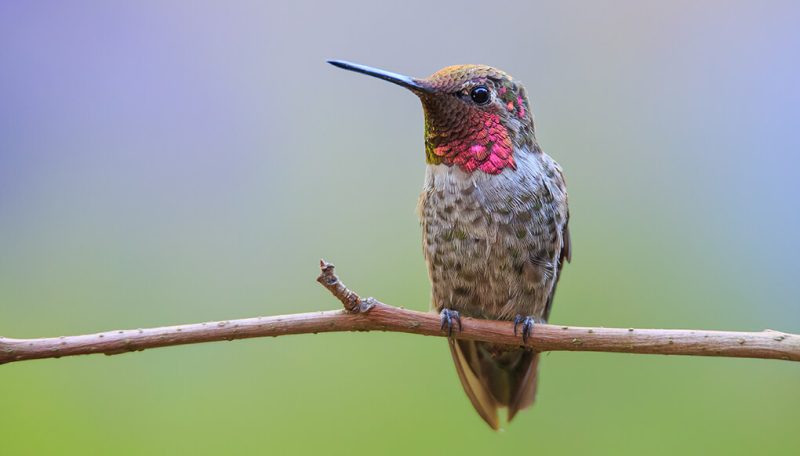
Anna’s Hummingbird is one of the few hummingbird species that stays in California year-round, thriving even through the mild winters. Males are instantly recognizable by their iridescent rose-pink throat and crown that shimmer in the sunlight, while females show green backs and faint reddish markings on the throat. They measure about 4 inches long with a wingspan of 5 inches.
These tiny birds are fiercely territorial, especially around feeders and flowering plants. Even in winter, they can be seen zipping through gardens and parks, hovering effortlessly to sip nectar or catch small insects in midair. Their distinctive high-pitched chirps often announce their presence long before they’re visible.
Anna’s Hummingbirds prefer areas with abundant blooms — coastal gardens, urban backyards, and chaparral regions. Their adaptability to ornamental flowers and nectar feeders allows them to survive and thrive during the cooler months.
While most hummingbirds migrate south for winter, Anna’s rely on California’s moderate climate and available nectar sources. They even begin nesting as early as December, making them one of the earliest breeders among North American birds.
White-breasted Nuthatch (Sitta carolinensis)
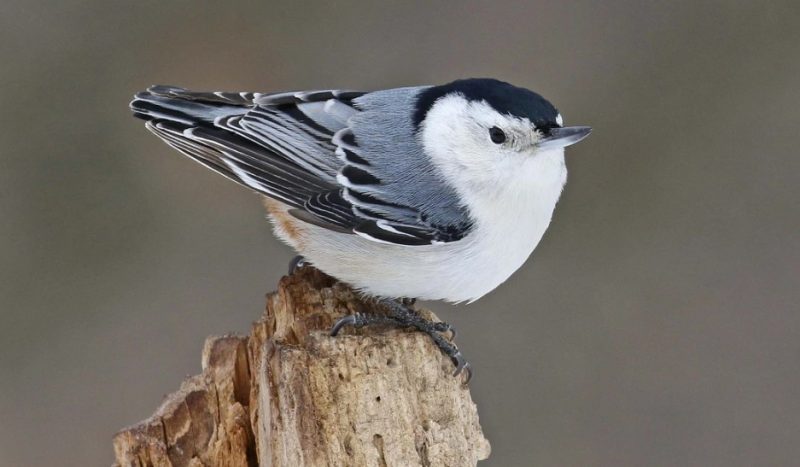
The White-breasted Nuthatch is a small bird with a distinct behavior — it climbs down trees headfirst while searching for insects and seeds. With a length of about 5 inches, it features a white face and chest, gray-blue back, and a black or dark gray crown. Its sturdy, slightly upturned bill is ideal for probing bark crevices.
During the winter months, nuthatches become regular visitors at suet feeders and seed trays, often seen alongside chickadees and woodpeckers. Their calls are short and nasal, sounding like a toy horn — an easy clue to their presence in wooded areas.
These birds prefer mature woodlands, oak forests, and suburban neighborhoods with tall trees. In California, they are common from coastal ranges to the Sierra Nevada foothills, where they seek shelter and food during colder weather.
They remain in their territories year-round but become more visible and vocal in winter as they store food in tree crevices and join mixed-species foraging flocks for safety and efficiency.
Lesser Goldfinch (Spinus psaltria)
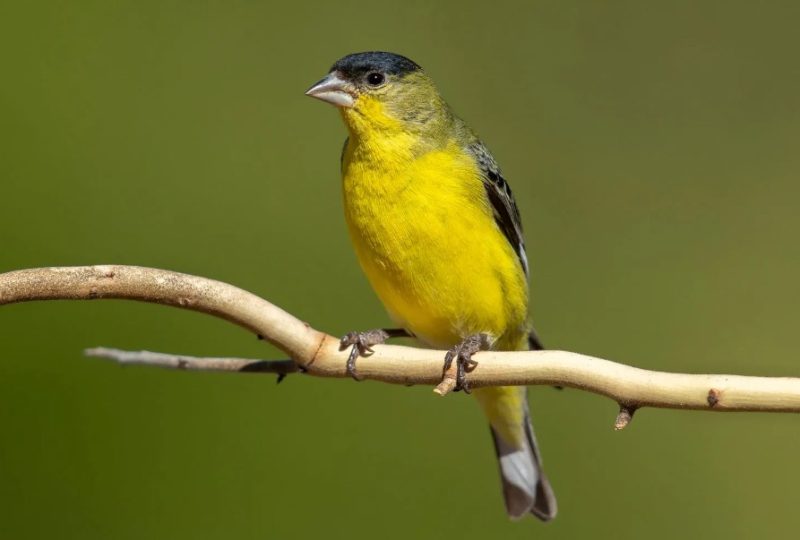
The Lesser Goldfinch is a small, vibrant songbird that adds color to California’s winter landscape. Adults measure around 4 to 4.5 inches long, with males displaying bright yellow underparts and glossy black caps, while females appear more subdued in olive tones. Their cheerful, twittering calls are often heard in flocks feeding on grass seeds.
They are highly social birds, frequently forming groups that move from one feeding area to another. During winter, they gather near feeders stocked with nyjer or sunflower seeds and in open fields full of dried seed heads.
In California, Lesser Goldfinches are common throughout the state, especially in the Central Valley and coastal foothills. They adapt well to suburban environments, often perching on fences and garden shrubs.
Unlike many migratory finches, this species stays year-round in California, though some individuals may move to lower elevations during colder weather. Their presence and lively songs bring brightness to the duller tones of winter days.
House Finch (Haemorhous mexicanus)
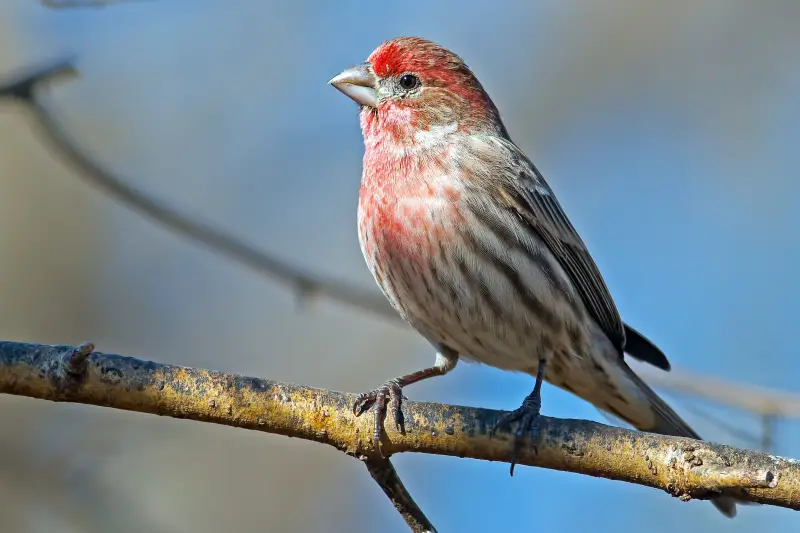
The House Finch is one of the most familiar backyard birds in California, easily recognized by the male’s rosy-red face and chest contrasted with brown streaked feathers. Females are brown and streaky throughout, blending in more subtly with their surroundings. Adults measure about 5 to 6 inches in length.
They are active, sociable birds that gather in flocks, especially during the winter. Their diet consists mainly of seeds, fruits, and buds, and they readily visit feeders filled with sunflower or millet seeds. Their pleasant, musical song is a common sound in California neighborhoods year-round.
House Finches thrive in urban, suburban, and rural areas alike. They build nests in eaves, hanging planters, and even traffic lights. During winter, they move around in search of consistent food sources but generally remain within the same region.
Because of their adaptability and tolerance for human presence, they are among the most widespread species across California — from the coasts to the deserts — and remain active even on cold winter days.
American Robin (Turdus migratorius)
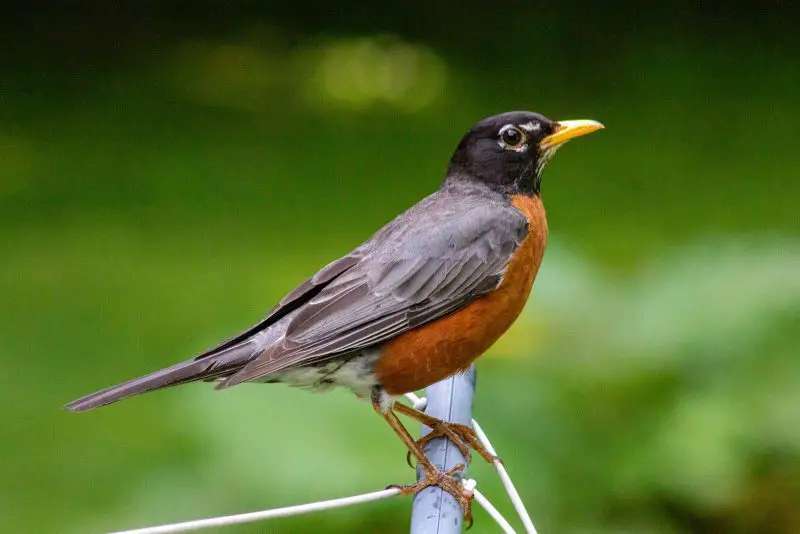
The American Robin, with its bright orange breast and grayish back, is a familiar sight during California’s winter months. Measuring about 10 inches long, robins are larger than most songbirds and have a confident, upright posture. Their clear, whistling call and cheerful demeanor make them easy to recognize.
In winter, large flocks of robins can be seen foraging on lawns, berry bushes, and orchards across the state. They mainly feed on fruits, such as holly and toyon berries, when insects become scarce. Their presence often signals the mildness of California’s climate compared to their frozen northern breeding grounds.
Robins are adaptable and can inhabit urban parks, agricultural fields, and forest edges. In California, their numbers swell dramatically in winter as migrants from northern regions arrive to take advantage of the state’s moderate temperatures and food supply.
By early spring, most robins migrate back north to breed, but some stay year-round in coastal or mountain areas where conditions remain favorable. Their return northward often coincides with the first blooms of spring.
Cedar Waxwing (Bombycilla cedrorum)
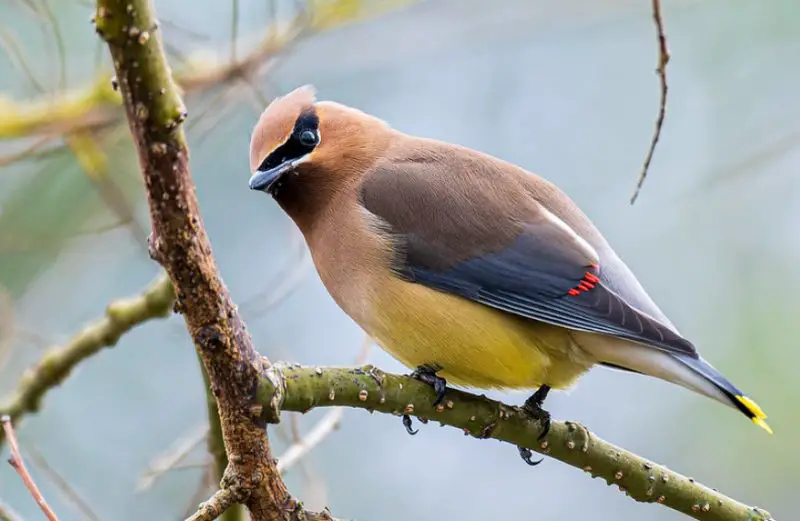
The Cedar Waxwing is one of the most elegant winter visitors in California, recognized by its smooth, silky plumage, pointed crest, and yellow-tipped tail. Adults measure about 6 to 7 inches long, with a soft blend of tan, gray, and yellow feathers, and striking red wax-like tips on their secondary wings — the feature that gives them their name.
These birds are highly social and often move in flocks, gliding gracefully between fruiting trees. During winter, they feed almost entirely on berries such as toyon, mistletoe, and juniper. Their gentle, high-pitched calls can often be heard even before the flock is seen.
Cedar Waxwings are found across California in the winter months, especially in orchards, suburban parks, and riparian woodlands. They follow the availability of berries, sometimes appearing in large groups and then vanishing once a food source is depleted.
As spring approaches, these birds migrate northward to breed across Canada and the northern U.S., leaving behind their soft, whispery trills as a reminder of the season’s calm beauty.
Northern Flicker (Colaptes auratus)
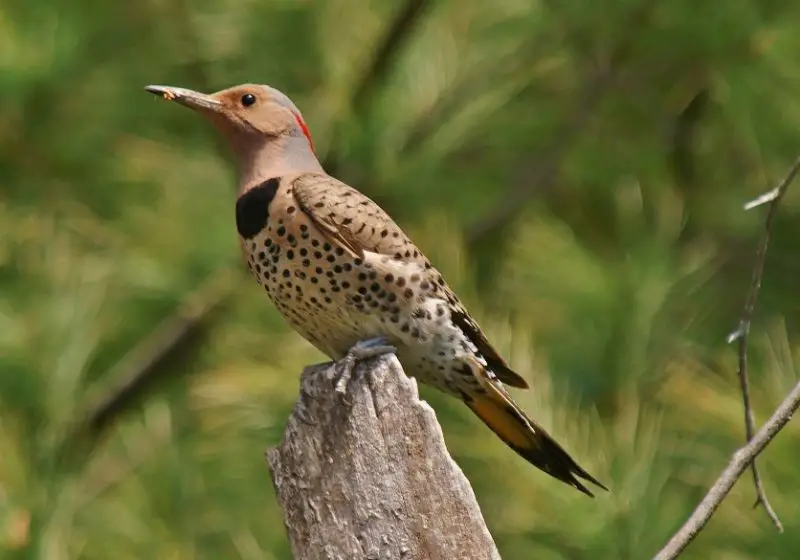
The Northern Flicker is a large, distinctive woodpecker with a length of about 11 to 12 inches. Its patterned plumage features a brownish back with black bars, a spotted underside, and bright reddish-orange underwings visible during flight. In California, the “Red-shafted” form is most common.
Unlike most woodpeckers, Northern Flickers often forage on the ground, probing for ants and beetles with their long, slightly curved bill. They also visit suet feeders during the winter and can be recognized by their loud, sharp “wicka-wicka” calls.
These birds are adaptable and can be found in open woodlands, forest edges, and suburban areas throughout California. During the colder months, they descend from higher elevations to lower valleys and urban parks where food is easier to find.
Northern Flickers are resident in much of the state year-round, though some northern populations migrate southward in winter. Their striking plumage and rhythmic drumming sounds make them one of California’s most noticeable winter birds.
Spotted Towhee (Pipilo maculatus)
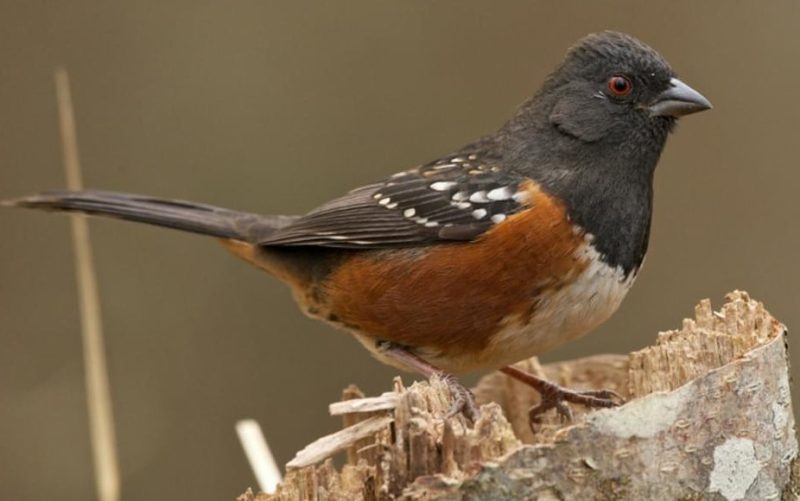
The Spotted Towhee is a striking bird with bold colors — a black hood and back, rufous-orange sides, and white belly. Males are more vividly colored than females, and both have piercing red eyes. Adults average 7 to 8 inches long, with a robust body and long tail tipped in white.
Towhees prefer dense thickets and brushy areas, where they scratch vigorously through leaf litter for seeds, berries, and insects. They are known for their distinctive double-footed “hop and scratch” feeding behavior. Their sharp, rising call note is often the first clue to their presence.
In California, Spotted Towhees are common residents across the state, from coastal scrublands to oak woodlands and foothills. During winter, they often venture closer to backyards and feeders, especially where dense cover is available.
Although many are year-round residents, some northern populations move southward for winter. Their vivid coloration and energetic movements make them a lively addition to California’s winter landscape.
Western Bluebird (Sialia mexicana)
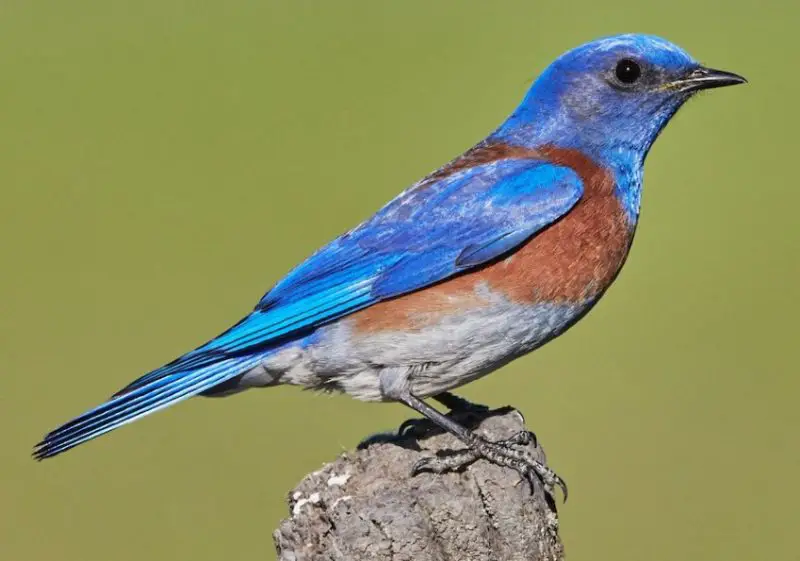
The Western Bluebird adds brilliant color to California’s winter scenery with its deep blue wings and orange-rust chest. Males are especially vivid, while females display softer blue-gray tones. They measure about 6 to 7 inches long and have a plump, compact body with a short, straight bill.
These birds often perch on fence posts or low branches, scanning for insects on the ground. In winter, their diet shifts more toward berries and fruits, and they often form small flocks that move through open woodlands and meadows.
Western Bluebirds are common across California during the winter months, particularly in the Central Valley, coastal regions, and foothills. They prefer open areas with scattered trees or nest boxes for shelter.
Some populations are permanent residents, while others migrate slightly depending on food availability and elevation. Their gentle warbling calls and brilliant colors make them a favorite among winter birdwatchers.
Red-tailed Hawk (Buteo jamaicensis)
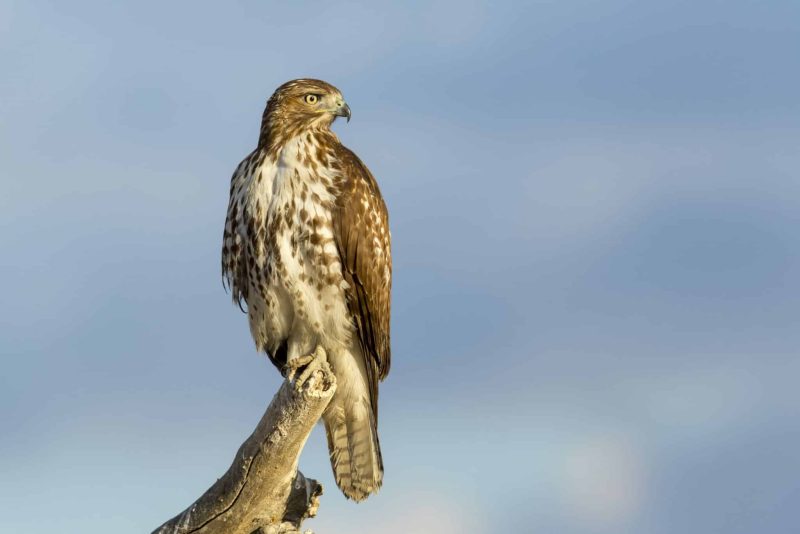
The Red-tailed Hawk is one of the most widespread and easily recognized raptors in North America. Adults measure about 18 to 22 inches in length with a wingspan of up to 4 feet. Their reddish-brown tail, broad wings, and pale underparts with a dark belly band are key identifying features.
In California, Red-tailed Hawks are common year-round, but their numbers increase in winter as migrants from northern regions join resident populations. They can be seen soaring over fields, perched on utility poles, or circling high in the sky scanning for prey.
Their diet consists mainly of rodents, small mammals, and birds, making them crucial for maintaining ecological balance. During colder months, open grasslands and agricultural fields become prime hunting grounds.
Red-tailed Hawks adapt to nearly every habitat in California, from deserts to forests and coastal cliffs. Their distinctive, raspy scream is a familiar sound in the winter air, symbolizing the wild spirit of California’s open landscapes.
Song Sparrow (Melospiza melodia)
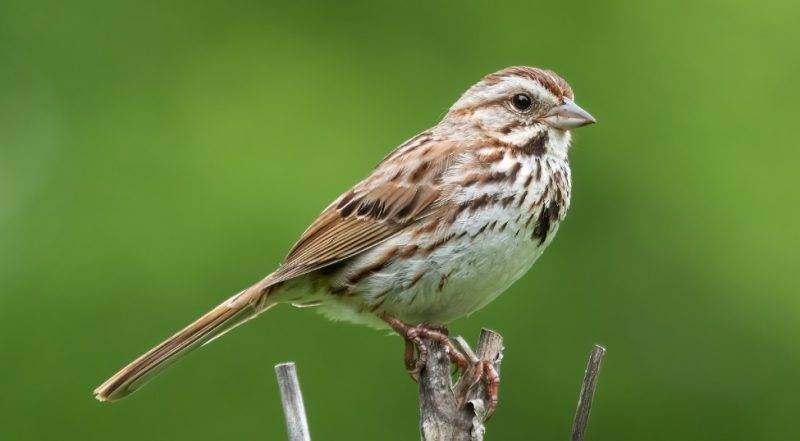
The Song Sparrow is one of the most familiar and widespread small birds in California, especially during the winter months. Measuring around 5 to 6 inches long, it has brown-streaked plumage, a rounded tail, and a distinct dark spot in the center of its breast. Its appearance blends perfectly with reeds and brush along wetlands.
This sparrow is best known for its beautiful, varied song — a clear series of whistles and trills that can brighten even a gray winter morning. Song Sparrows are year-round residents in much of California, but populations from colder inland areas often move toward coastal regions when temperatures drop.
They favor habitats near water, such as marshes, riverbanks, and damp gardens, where they forage on seeds and insects. In winter, they often visit backyard feeders and can be seen scratching on the ground for food.
Their adaptability and constant presence make them one of the defining voices of California’s birdlife, equally at home in wild wetlands and suburban yards throughout the winter season.
California Scrub-Jay (Aphelocoma californica)
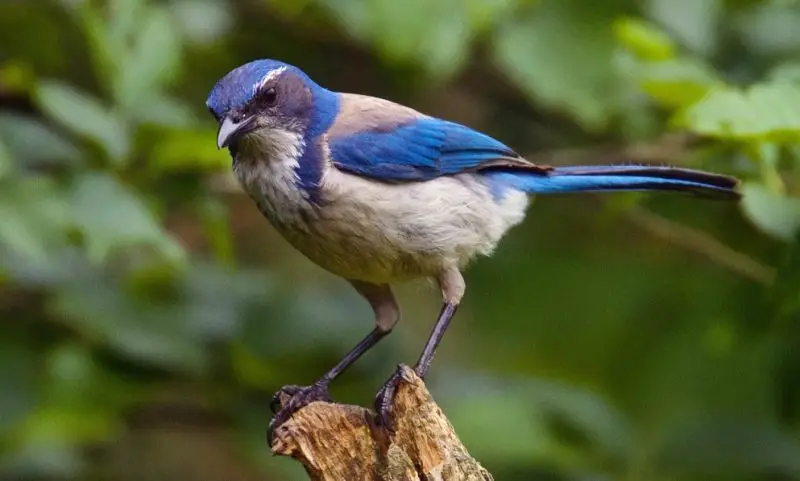
The California Scrub-Jay is a bold, intelligent bird known for its bright blue plumage, gray chest, and expressive behavior. It measures about 11 inches long and has a strong, slightly hooked bill perfect for cracking acorns or probing soil. Its loud, harsh calls are a common sound in many California neighborhoods.
These jays are curious and opportunistic, often caching acorns and other food in the fall to retrieve during the winter. They are quick learners, capable of remembering the locations of hundreds of hidden stashes. Their intelligence rivals that of crows and ravens.
In winter, Scrub-Jays become especially visible as they frequent feeders and oak woodlands in search of stored food. They are common from the coastal plains to foothill regions, thriving in chaparral, gardens, and city parks.
Because California’s winters are mild, these birds remain active year-round. Their vibrant blue feathers and assertive behavior add color and energy to the quieter winter landscape.
Mourning Dove (Zenaida macroura)
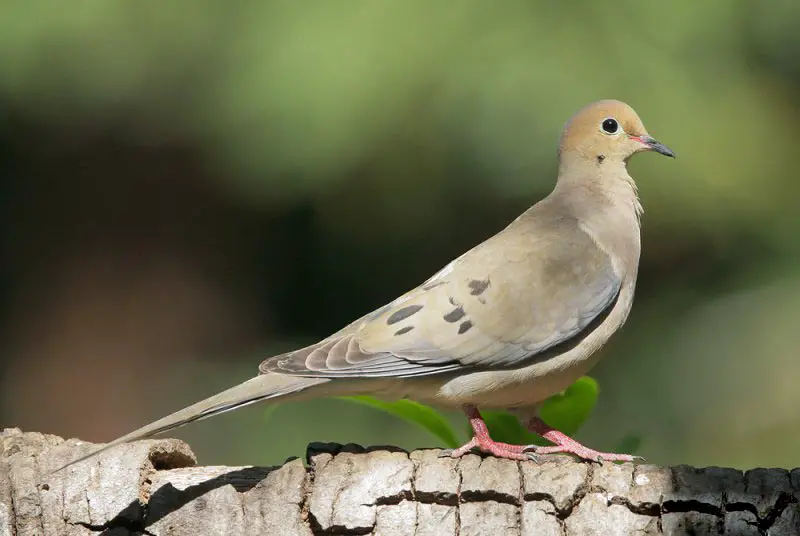
The Mourning Dove is a slender, graceful bird with soft grayish-tan plumage and a distinctive long, pointed tail edged in white. Adults measure about 12 inches long with delicate black spots on their wings and a small, black beak. Their mournful, cooing call gives them their name.
These doves are present throughout California year-round, but they often gather in small flocks during the winter months. It’s common to see them perched along power lines, rooftops, or foraging quietly on open ground for seeds and grains.
They prefer open habitats such as farmlands, suburban areas, and desert scrub, where they can find scattered seeds and gravel for digestion. During cold mornings, Mourning Doves sun themselves on fences or rooftops to warm up.
Their peaceful nature and soothing calls make them a symbol of calm during California’s mild winter days. Despite their delicate appearance, they are resilient birds capable of enduring diverse conditions across the state.
Northern Mockingbird (Mimus polyglottos)
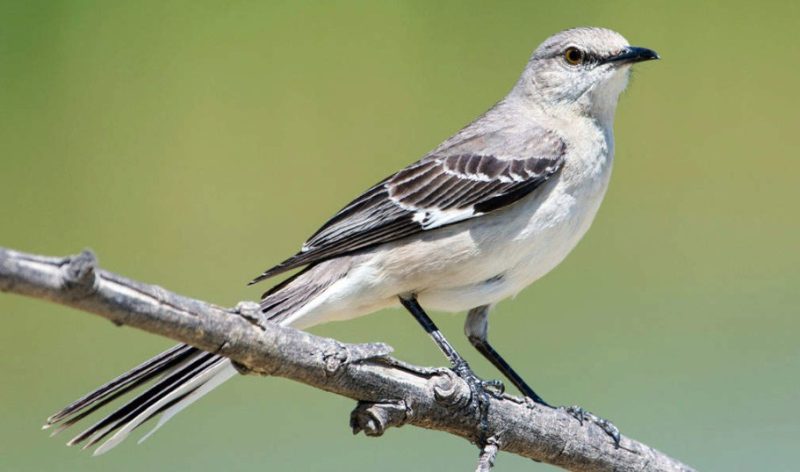
The Northern Mockingbird is renowned for its unmatched ability to imitate the songs and calls of dozens of other birds — sometimes even mechanical noises. It’s a medium-sized songbird about 10 inches long, with gray plumage, white wing patches, and a long tail that it frequently flicks while perching.
Mockingbirds are active year-round in California, particularly in the southern and coastal regions where winters are mild. They defend their territories aggressively, even in colder months, and often sing through the day — and sometimes at night under bright streetlights.
During winter, they feed mainly on berries and fruits but will also catch insects when available. You can often spot them darting between shrubs and fruiting trees in parks, gardens, and urban areas.
Their lively personalities and melodic variety make them one of the most entertaining birds to watch during California’s winter season, providing sound and movement when many other species grow quiet.
Black Phoebe (Sayornis nigricans)
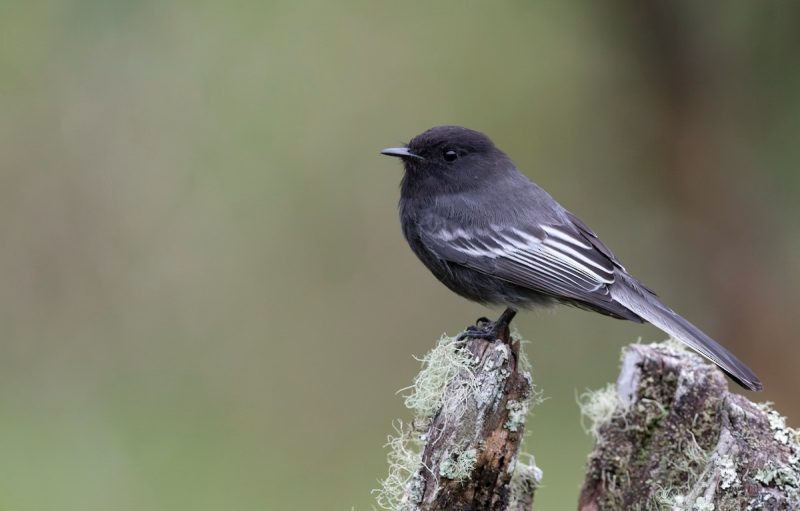
The Black Phoebe is a small, sleek flycatcher easily identified by its black upperparts, white belly, and habit of tail-bobbing while perched. Measuring about 6 inches long, it has a compact body, dark eyes, and a sharp, pointed bill suited for catching insects midair.
These birds prefer areas near water — ponds, creeks, and fountains — where they can hunt for flying insects. Even during the winter, they remain active, sallying out from low perches to snatch prey before returning to the same spot.
In California, Black Phoebes are abundant year-round, but their presence feels especially noticeable in winter when other insect-eating birds migrate south. They adapt well to urban environments, often nesting on building ledges, bridges, or patios.
Their quiet “tsip-tsip” calls and rhythmic tail movements make them easy to recognize. They bring energy and life to quiet winter days, embodying California’s mild climate and vibrant biodiversity.
Hermit Thrush (Catharus guttatus)
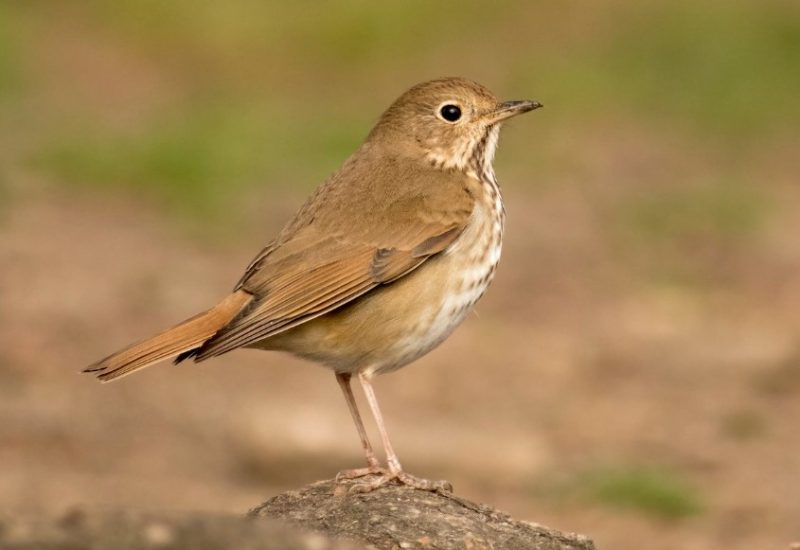
The Hermit Thrush is a quiet, secretive migrant known for its beautiful, flute-like song that carries softly through forested landscapes. Measuring about 6.5 to 7 inches long, it has a warm brown back, a reddish tail, and a white chest covered in neat brown spots. Its gentle demeanor and elegant appearance make it one of California’s most graceful winter visitors.
During the colder months, Hermit Thrushes can be found in shaded woodlands, canyon thickets, and even quiet suburban gardens. They forage on the ground, flicking leaves aside to uncover insects and berries. Their habit of raising their reddish tail slightly before dropping it back down helps distinguish them from other thrush species.
In California, this species is mainly seen from October through April, migrating from breeding grounds in Canada and the northern U.S. Many choose coastal and foothill habitats where food and shelter remain plentiful during winter.
By late spring, Hermit Thrushes head north again, leaving behind a peaceful stillness in the forests. Their haunting, melodic song is often considered one of the most beautiful in North America.
Townsend’s Warbler (Setophaga townsendi)
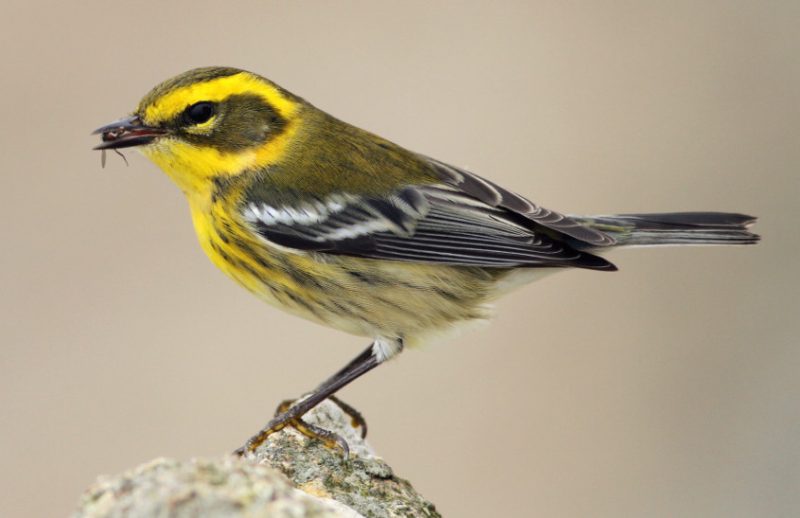
The Townsend’s Warbler is a vibrant, eye-catching songbird with striking yellow and black markings. It measures around 4.5 inches long, with a brilliant yellow face framed by a bold black mask, a black throat, and white underparts streaked with dark lines. Its bright plumage brings a burst of color to California’s winter canopy.
These warblers are highly active, flitting through coniferous trees in search of insects and spiders. They often join mixed-species flocks with kinglets, chickadees, and nuthatches, moving constantly through branches. Their thin, high-pitched calls help them communicate while feeding.
In winter, Townsend’s Warblers migrate south from their breeding grounds in the Pacific Northwest and Alaska to California’s coastal forests, foothills, and even city parks. They are particularly abundant in the state’s western regions, where mild temperatures allow insects to persist.
By early spring, they begin their northward migration again, often overlapping briefly with other colorful migrants before disappearing into their breeding territories.
American Kestrel (Falco sparverius)
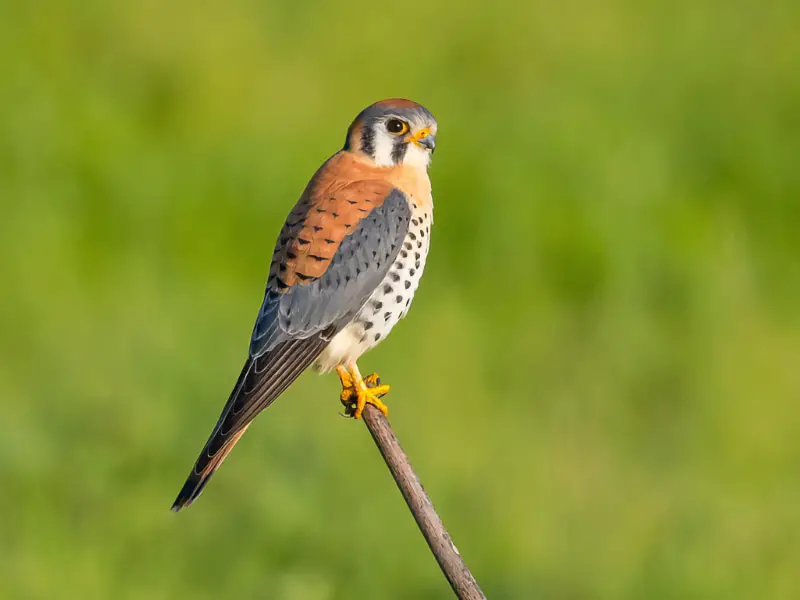
The American Kestrel is the smallest falcon in North America, measuring only about 9 to 12 inches long, yet it displays bold colors and confident behavior. Males are easily recognized by their blue-gray wings, rusty backs, and black-spotted chests, while females have more uniform reddish-brown tones. Both have sharp black facial markings typical of falcons.
These agile raptors can often be seen perched on power lines or fence posts, scanning open fields for small prey. They feed on insects, rodents, and small birds, diving swiftly to capture their targets. Their hovering flight — holding position in the air while watching for movement below — is one of their most distinctive behaviors.
In California, kestrels are common year-round, but their numbers rise in winter as northern migrants join resident populations. They thrive in open habitats such as farmland, grasslands, and desert edges where visibility and hunting opportunities are high.
Despite their small size, American Kestrels are fierce hunters and highly adaptable. Their presence in winter skies adds a flash of color and vitality to California’s landscapes.
White-tailed Kite (Elanus leucurus)
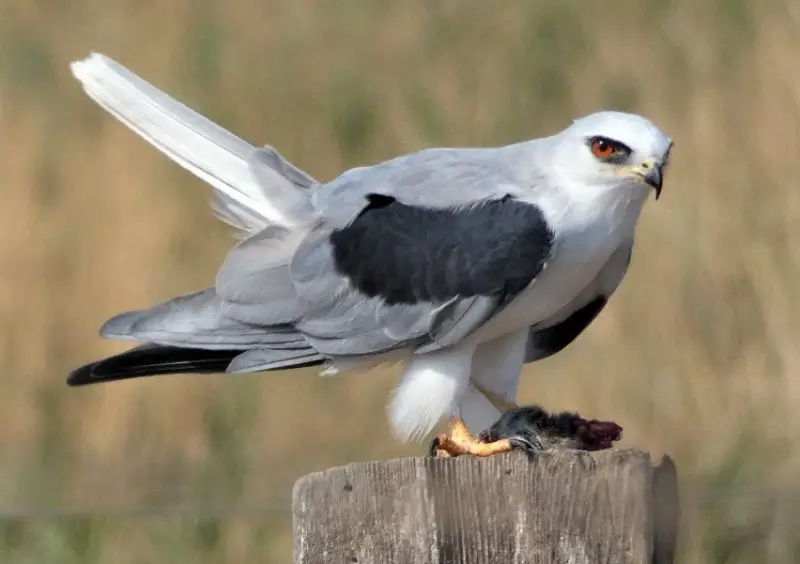
The White-tailed Kite is a graceful raptor, pure white below with soft gray wings and distinctive red eyes. Adults measure about 15 inches in length, with long, narrow wings that allow them to hover effortlessly over open fields. Their buoyant flight and ghostly appearance make them easy to recognize from a distance.
These kites specialize in hunting small mammals, particularly voles and mice, which they spot from above while hovering in midair — a behavior known as “kiting.” Once prey is detected, they dive swiftly, striking with precision.
In California, White-tailed Kites are found year-round, but they are especially visible during winter when populations from northern areas move southward. They favor open grasslands, marshes, and agricultural areas, often near wetlands or pastures.
This species once declined due to habitat loss but has rebounded strongly in California thanks to conservation efforts. Their elegant form and hunting grace make them one of the most captivating winter raptors in the state.
Great Egret (Ardea alba)
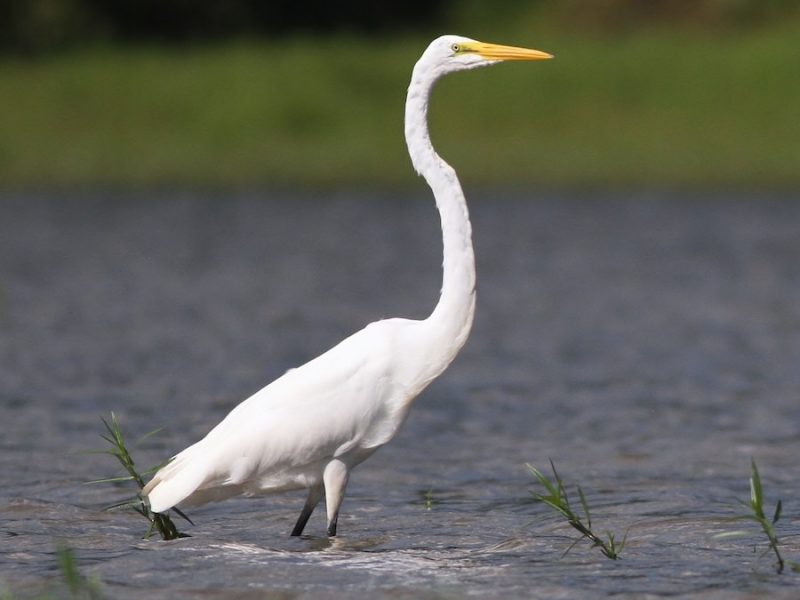
The Great Egret is a large, majestic wading bird with immaculate white plumage, a long S-curved neck, and a sharp yellow bill. Standing nearly 3.5 feet tall with a wingspan of about 5 feet, it is among the most striking birds in California’s wetlands. Its slow, deliberate movements convey an air of quiet dignity.
During winter, Great Egrets can be found in freshwater marshes, estuaries, flooded fields, and coastal lagoons throughout California. They feed primarily on fish, frogs, and small aquatic creatures, which they catch with quick, precise strikes of their bill.
These birds are common year-round in much of the state, though their numbers increase in winter as migrants arrive from farther north. Their brilliant white plumage often stands out against the muted tones of the season’s vegetation.
The sight of a Great Egret gliding low over a foggy marsh or standing motionless in shallow water has long symbolized the serene beauty of California’s winter wetlands. Their presence signals the health and diversity of the state’s aquatic ecosystems.
Conclusion
Winter in California is a season of quiet beauty filled with color and sound. Across the valleys, mountains, and coastlines, birds continue to bring life to the landscape even during the coldest days. The sight of a red-breasted robin on a frosty lawn or a white egret standing motionless in a misty wetland shows how much diversity the season holds.
Many of these birds stay through the entire winter, depending on local food and mild weather to survive. Others use California as a temporary refuge before returning north in spring. No matter where you look, from city parks to coastal lagoons, each bird adds a small piece to the story of California’s vibrant ecosystems.
Taking the time to notice these creatures brings calm and appreciation for the natural rhythm of the seasons. A simple morning walk or a feeder near a window can reveal more life and color than most people imagine during the winter months.
FAQs About Winter Birds in California
When is the best time to see winter birds in California?
The best months for spotting winter birds are from November through February. During this period, northern migrants have already arrived, and most species remain active and visible before spring migration begins in March.
Where can I see winter birds in California?
Some of the most rewarding locations include Sacramento National Wildlife Refuge, Point Reyes National Seashore, Bolsa Chica Ecological Reserve, and Elkhorn Slough. City parks, foothill forests, and coastal wetlands also attract a variety of species.
Do hummingbirds stay in California during winter?
Yes, several species stay through the winter, especially Anna’s Hummingbird. Thanks to California’s mild climate and flowering plants, they remain active even in the cold months and can often be seen visiting nectar feeders.
What can I feed birds during winter?
You can attract winter birds with black oil sunflower seeds, millet, suet, and cracked corn. Providing clean water and shelter from wind also helps them stay healthy and safe.
Are there migratory and resident birds in California during winter?
Yes. Some birds such as the White-crowned Sparrow and Golden-crowned Sparrow migrate from northern regions, while others like the California Scrub-Jay and Anna’s Hummingbird live in the state all year. Both types are easily observed throughout the winter season.

